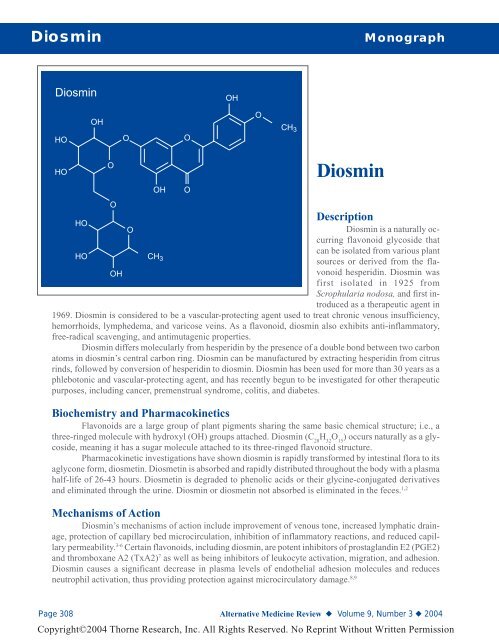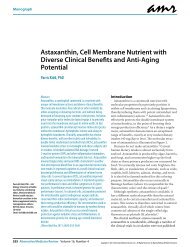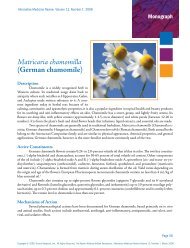Diosmin Monograph - Alternative Medicine Review
Diosmin Monograph - Alternative Medicine Review
Diosmin Monograph - Alternative Medicine Review
You also want an ePaper? Increase the reach of your titles
YUMPU automatically turns print PDFs into web optimized ePapers that Google loves.
<strong>Diosmin</strong> <strong>Monograph</strong><br />
<strong>Diosmin</strong><br />
HO<br />
HO<br />
OH<br />
O<br />
O O<br />
OH O<br />
OH<br />
<strong>Diosmin</strong><br />
O<br />
HO<br />
O<br />
Description<br />
<strong>Diosmin</strong> is a naturally occurring<br />
flavonoid glycoside that<br />
HO<br />
CH3<br />
can be isolated from various plant<br />
sources or derived from the fla-<br />
OH<br />
vonoid hesperidin. <strong>Diosmin</strong> was<br />
first isolated in 1925 from<br />
Scrophularia nodosa, and first introduced<br />
as a therapeutic agent in<br />
1969. <strong>Diosmin</strong> is considered to be a vascular-protecting agent used to treat chronic venous insufficiency,<br />
hemorrhoids, lymphedema, and varicose veins. As a flavonoid, diosmin also exhibits anti-inflammatory,<br />
free-radical scavenging, and antimutagenic properties.<br />
<strong>Diosmin</strong> differs molecularly from hesperidin by the presence of a double bond between two carbon<br />
atoms in diosmin’s central carbon ring. <strong>Diosmin</strong> can be manufactured by extracting hesperidin from citrus<br />
rinds, followed by conversion of hesperidin to diosmin. <strong>Diosmin</strong> has been used for more than 30 years as a<br />
phlebotonic and vascular-protecting agent, and has recently begun to be investigated for other therapeutic<br />
purposes, including cancer, premenstrual syndrome, colitis, and diabetes.<br />
Biochemistry and Pharmacokinetics<br />
Flavonoids are a large group of plant pigments sharing the same basic chemical structure; i.e., a<br />
three-ringed molecule with hydroxyl (OH) groups attached. <strong>Diosmin</strong> (C 28 H 32 O 15 ) occurs naturally as a glycoside,<br />
meaning it has a sugar molecule attached to its three-ringed flavonoid structure.<br />
Pharmacokinetic investigations have shown diosmin is rapidly transformed by intestinal flora to its<br />
aglycone form, diosmetin. Diosmetin is absorbed and rapidly distributed throughout the body with a plasma<br />
half-life of 26-43 hours. Diosmetin is degraded to phenolic acids or their glycine-conjugated derivatives<br />
and eliminated through the urine. <strong>Diosmin</strong> or diosmetin not absorbed is eliminated in the feces. 1,2<br />
Mechanisms of Action<br />
<strong>Diosmin</strong>’s mechanisms of action include improvement of venous tone, increased lymphatic drainage,<br />
protection of capillary bed microcirculation, inhibition of inflammatory reactions, and reduced capillary<br />
permeability. 3-6 Certain flavonoids, including diosmin, are potent inhibitors of prostaglandin E2 (PGE2)<br />
and thromboxane A2 (TxA2) 7 as well as being inhibitors of leukocyte activation, migration, and adhesion.<br />
<strong>Diosmin</strong> causes a significant decrease in plasma levels of endothelial adhesion molecules and reduces<br />
neutrophil activation, thus providing protection against microcirculatory damage. 8,9<br />
Page 308 <strong>Alternative</strong> <strong>Medicine</strong> <strong>Review</strong> ◆ Volume 9, Number 3 ◆ 2004<br />
Copyright©2004 Thorne Research, Inc. All Rights Reserved. No Reprint Without Written Permission<br />
O<br />
CH 3
<strong>Monograph</strong> <strong>Diosmin</strong><br />
Clinical Indications<br />
Varicose Veins/Chronic Venous<br />
Insufficiency<br />
Chronic venous insufficiency is characterized<br />
by pain, leg heaviness, a sensation of swelling,<br />
and cramps, and is correlated with varicose<br />
veins. A multicenter international trial, carried out<br />
in 23 countries over two years, in which 5,052<br />
symptomatic patients were enrolled, evaluated the<br />
efficacy of flavonoids in the treatment of chronic<br />
venous insufficiency. Patients were treated with<br />
450 mg diosmin and 50 mg hesperidin daily for<br />
six months. Continuous clinical improvement was<br />
found throughout the study, as well as improvements<br />
in quality of life scores for participants. 10<br />
<strong>Diosmin</strong>-containing flavonoid mixtures<br />
have also been effective in treating severe stages<br />
of chronic venous insufficiency, including venous<br />
ulceration and delayed healing. 3,5 In a randomized<br />
multicenter trial, 900 mg diosmin and 100 mg<br />
hesperidin plus standard venous ulcer management<br />
was compared with standard venous ulcer management<br />
alone. Standard ulcer management included<br />
cleaning, compression therapy, and skin<br />
care of the adjacent skin. Forty-seven percent of<br />
patients in the treatment group compared to 28<br />
percent in the standard management group experienced<br />
complete healing of ulcers less than 10<br />
cm in diameter. 11<br />
Hemorrhoids<br />
Several large clinical trials have demonstrated<br />
diosmin to be effective in the treatment of<br />
acute and chronic symptoms of hemorrhoids. A<br />
double-blind, placebo-controlled study of 120<br />
patients showed improvement of pain, pruritis,<br />
discharge, edema, erythema, and bleeding on examination.<br />
12 The treatment group was given a flavonoid<br />
mixture (90% diosmin and 10% hesperidin)<br />
at a dose of two 500-mg tablets daily for two<br />
months.<br />
The use of diosmin in the treatment of<br />
hemorrhoids associated with pregnancy did not<br />
adversely affect pregnancy, fetal development,<br />
birth weight, infant growth, or infant feeding. Pregnant<br />
women suffering from acute hemorrhoids<br />
were treated eight weeks before delivery and four<br />
weeks after delivery. More than half of the women<br />
participating in the study reported relief from<br />
symptoms by the fourth day. 13 <strong>Diosmin</strong> is nonmutagenic<br />
and does not have any significant effect<br />
on reproductive function. 14<br />
Lymphedema<br />
<strong>Diosmin</strong> acts on the lymphatic system by<br />
increasing lymph flow and lymph oncotic pressure.<br />
15,16 A flavonoid mixture containing diosmin<br />
was used to treat upper limb lymphedema secondary<br />
to conventional therapy for breast cancer. Results<br />
showed improvement of symptoms and limb<br />
volume; the mean decrease in volume of the swollen<br />
limb reached 6.8 percent. 16 In addition, lymphatic<br />
functional parameters assessed with scintigraphy<br />
were significantly improved. Animal<br />
studies of high-protein lymphedema, such as in<br />
burns and lung contusions, showed significant<br />
improvement with diosmin. 17<br />
Diabetes<br />
<strong>Diosmin</strong> has been shown to improve factors<br />
associated with diabetic complications. Blood<br />
parameters of glycation and oxidative stress were<br />
measured in type 1 diabetic patients before and<br />
after intervention with a diosmin-containing flavonoid<br />
mixture. A decrease in hemoglobin A1c<br />
was accompanied by an increase in glutathione<br />
peroxidase, 18 demonstrating long-term decreased<br />
blood glucose levels and increased antioxidant<br />
activity.<br />
<strong>Diosmin</strong> can normalize capillary filtration<br />
rate and prevent ischemia in diabetics. Rheological<br />
studies of type 1 diabetics show diosmin can<br />
facilitate hemorheological improvements due to<br />
decreased RBC aggregation, which decreases<br />
blood flow resistance, resulting in reduction of<br />
both stasis and ischemia. 19-21<br />
Cancer<br />
<strong>Diosmin</strong> has been investigated in a number<br />
of animal models and human cancer cell lines,<br />
and has been found to be chemopreventive and<br />
antiproliferative. 22-26 More clinically oriented research<br />
in this area is warranted to determine effective<br />
dosages and protocols.<br />
<strong>Alternative</strong> <strong>Medicine</strong> <strong>Review</strong> ◆ Volume 9, Number 3 ◆ 2004 Page 309<br />
Copyright©2004 Thorne Research, Inc. All Rights Reserved. No Reprint Without Written Permission
<strong>Diosmin</strong> <strong>Monograph</strong><br />
Other Clinical Indications<br />
Studies have also investigated the use of<br />
diosmin for stasis dermatitis, 3 wound healing, 27<br />
premenstrual syndrome, 28 mastodynia, 29,30<br />
dermatofibrosclerosis, 3 viral infections, 31 and colitis.<br />
32 More clinically oriented research is indicated.<br />
Drug-Nutrient Interactions<br />
<strong>Diosmin</strong> can cause a decrease in RBC<br />
aggregation and blood viscosity. 19 There are no<br />
documented cases of adverse interactions between<br />
diosmin and prescription medications, but caution<br />
should be taken when combining diosmin with<br />
aspirin or other blood-thinning medications.<br />
Data suggest that diosmin has an inhibitory<br />
effect on cytochrome P450-mediated metabolism<br />
in healthy volunteers, which may alter the<br />
pharmacokinetics of drugs taken concomitantly.<br />
Patients given metronidazole after nine days of<br />
pretreatment with 450 mg diosmin demonstrated<br />
changes in serum concentrations of metronidazole,<br />
as well as changes in urinary concentrations of<br />
metronidazole and its metabolites compared to<br />
controls. 33<br />
Side Effects and Toxicity<br />
In animal studies, a flavonoid mixture<br />
containing 90-percent diosmin and 10-percent<br />
hesperidin had an LD 50 of more than 3g/kg. In<br />
addition, animal studies have shown the absence<br />
of acute, subacute, or chronic toxicity after repeated<br />
oral dosing for 13 and 26 weeks using a<br />
dose representing 35 times the recommended daily<br />
dose. 14<br />
<strong>Diosmin</strong> is considered to have no mutagenic<br />
activity, embryo toxicity, nor any significant<br />
effect on reproductive function. Transplacental<br />
migration and passage into breast milk are minimal.<br />
14<br />
Dosage<br />
The standard dose of diosmin is 500 mg<br />
twice daily. For acute dosing, a loading dose of<br />
1,000 mg three times daily for four days is recommended,<br />
followed by 1,000 mg twice daily for<br />
three days, and a maintenance dose of 500 mg<br />
twice daily for two months.<br />
References<br />
1. Cova D, De Angelis L, Giavarini F, et al.<br />
Pharmacokinetics and metabolism of oral<br />
diosmin in healthy volunteers. Int J Clin<br />
Pharmacol Ther Toxicol 1992;30:29-33.<br />
2. Lyseng-Williamson KA, Perry CM.<br />
Micronised purified flavonoid fraction: a<br />
review of its use in chronic venous insufficiency,<br />
venous ulcers and haemorrhoids.<br />
Drugs 2003;63:71-100.<br />
3. Ramelet AA. Clinical benefits of Daflon 500<br />
mg in the most severe stages of chronic venous<br />
insufficiency. Angiology 2001;52:S49-S56.<br />
4. Smith PD. Neutrophil activation and mediators<br />
of inflammation in chronic venous insufficiency.<br />
J Vasc Res 1999;36:24-36.<br />
5. Bergan JJ, Schmid-Schonbein GW, Takase S.<br />
Therapeutic approach to chronic venous<br />
insufficiency and its complications: place of<br />
Daflon 500 mg. Angiology 2001;52:S43-S47.<br />
6. Le Devehat C, Khodabandehlou T, Vimeux M,<br />
Kempf C. Evaluation of haemorheological and<br />
microcirculatory disturbances in chronic<br />
venous insufficiency: activity of Daflon 500<br />
mg. Int J Microcirc Clin Exp 1997;17:27-33.<br />
7. Labrid C. Pharmacologic properties of Daflon<br />
500 mg. Angiology 1994;45:524-530.<br />
8. Ramelet AA. Pharmacologic aspects of a<br />
phlebotropic drug in CVI-associated edema.<br />
Angiology 2000;51:19-23.<br />
9. Manthey JA. Biological properties of flavonoids<br />
pertaining to inflammation. Microcirculation<br />
2000;7:S29-S34.<br />
10. Jantet G. Chronic venous insufficiency:<br />
worldwide results of the RELIEF study. Reflux<br />
assessment and quality of life improvement<br />
with micronized flavonoids. Angiology<br />
2002;53:245-256.<br />
11. Glinski W, Chodynicka B, Roszkiewicz J, et<br />
al. The beneficial augmentative effect of<br />
micronised purified flavonoid fraction (MPFF)<br />
on the healing of leg ulcers: an open,<br />
multicenter, controlled, randomized study.<br />
Phlebology 1999;14:151-157.<br />
12. Godeberge P. Daflon 500 mg in the treatment<br />
of hemorrhoidal disease: a demonstrated<br />
efficacy in comparison with placebo. Angiology<br />
1994;45:574-578.<br />
13. Buckshee K, Takkar D, Aggarwal N. Micronized<br />
flavonoid therapy in internal hemorrhoids<br />
of pregnancy. Int J Gynaecol Obstet<br />
1997;57:145-151.<br />
Page 310 <strong>Alternative</strong> <strong>Medicine</strong> <strong>Review</strong> ◆ Volume 9, Number 3 ◆ 2004<br />
Copyright©2004 Thorne Research, Inc. All Rights Reserved. No Reprint Without Written Permission
<strong>Monograph</strong> <strong>Diosmin</strong><br />
14. Meyer OC. Safety and security of Daflon 500<br />
mg in venous insufficiency and in hemorrhoidal<br />
disease. Angiology 1994;45:579-584.<br />
15. Pecking AP, Fevrier B, Wargon C, Pillion G.<br />
Efficacy of Daflon 500 mg in the treatment of<br />
lymphedema (secondary to conventional<br />
therapy of breast cancer). Angiology<br />
1997;48:93-98.<br />
16. Pecking AP. Evaluation by lymphoscintigraphy<br />
of the effect of a micronized flavonoid fraction<br />
(Daflon 500 mg) in the treatment of upper<br />
limb lymphedema. Int Angiology 1995;14:39-<br />
43.<br />
17. Casley-Smith JR, Casley-Smith JR. The effects<br />
of diosmin (a benzo-pyrone) upon some highprotein<br />
oedemas: lung contusion, and burn and<br />
lymphoedema of rat legs. Agents Actions<br />
1985;17:14-20.<br />
18. Manuel Y, Keenoy B, Vertommen J, De Leeuw<br />
I. The effect of flavonoid treatment on the<br />
glycation and antioxidant status in type 1<br />
diabetic patients. Diabetes Nutr Metab<br />
1999;12:256-263.<br />
19. Lacombe C, Bucherer C, Lelievre JC.<br />
Hemorheological improvement after Daflon<br />
500 mg treatment in diabetes. Int Angiol<br />
1988;7:21-24.<br />
20. Lacombe C, Lelievre JC, Bucherer C,<br />
Grimaldi A. Activity of Daflon 500 mg on the<br />
hemorheological disorders in diabetes. Int<br />
Angiol 1989;8:45-48.<br />
21. Valensi PE, Behar A, de Champvallins MM, et<br />
al. Effects of a purified micronized flavonoid<br />
fraction on capillary filtration in diabetic<br />
patients. Diabet Med 1996;13:882-888.<br />
22. Kuntz S, Wenzel U, Daniel H. Comparative<br />
analysis of the effects of flavonoids on<br />
proliferation, cytotoxicity, and apoptosis in<br />
human colon cancer cell lines. Eur J Nutr<br />
1999;38:133-142.<br />
23. Yang M, Tanaka T, Hirose Y, et al.<br />
Chemopreventive effects of diosmin and<br />
hesperidin on N-butyl-N-(4-hydroxybutyl)<br />
nitrosamine-induced urinary-bladder carcinogenesis<br />
in male ICR mice. Int J Cancer<br />
1997;73:19-24.<br />
24. Tanaka T, Makita H, Kawabata K, et al.<br />
Modulation of N-methyl-N-amylnitrosamineinduced<br />
rat oesophageal tumourigenesis by<br />
dietary feeding of diosmin and hesperidin,<br />
both alone and in combination. Carcinogenesis<br />
1997;18:761-769.<br />
25. Tanaka T, Makita H, Kawabata K, et al.<br />
Chemoprevention of azoxymethane-induced<br />
rat colon carcinogenesis by the naturally<br />
occurring flavonoids, diosmin and hesperidin.<br />
Carcinogenesis 1997;18:957-965.<br />
26. Tanaka T, Makita H, Ohnishi M, et al.<br />
Chemoprevention of 4-nitroquinoline 1-oxideinduced<br />
oral carcinogenesis in rats by flavonoids<br />
diosmin and hesperidin, each alone<br />
and in combination. Cancer Res 1997;57:246-<br />
252.<br />
27. Hasanoglu A, Ara C, Ozen S, et al. Efficacy of<br />
micronized flavonoid fraction in healing of<br />
clean and infected wounds. Int J Angiol<br />
2001;10:41-44.<br />
28. Serfaty D, Magneron AC. Premenstrual<br />
syndrome in France: epidemiology and<br />
therapeutic effectiveness of 1000 mg of<br />
micronized purified flavonoid fraction in 1,473<br />
gynecological patients. Contracept Fertil Sex<br />
1997;25:85-90. [Article in French]<br />
29. Meggiorini ML, Cascialli GL, Luciani S, et al.<br />
Randomized study of the use of synthetic<br />
diosmin in premenstrual and vascular dysplastic<br />
mastodynia. Minerva Ginecol 1990;42:421-<br />
425. [Article in Italian]<br />
30. Ciardetti P, Zucconi G, Ottanelli S, Casparis D.<br />
Treatment of mastodynia with synthetic<br />
diosmin. Ann Ostet Ginecol Med Perinat<br />
1985;106:258-266. [Article in Italian]<br />
31. Bae EA, Han MJ, Lee M, Kim DH. In vitro<br />
inhibitory effect of some flavonoids on<br />
rotavirus infectivity. Biol Pharm Bull<br />
2000;23:1122-1124.<br />
32. Crespo ME, Galvez J, Cruz T, et al. Antiinflammatory<br />
activity of diosmin and hesperidin<br />
in rat colitis induced by TNBS. Planta<br />
Med 1999;65:651-653.<br />
33. Rajnarayana K, Reddy MS, Krishna DR.<br />
<strong>Diosmin</strong> pretreatment affects bioavailability of<br />
metronidazole. Eur J Clin Pharmacol<br />
2003;58:803-807.<br />
<strong>Alternative</strong> <strong>Medicine</strong> <strong>Review</strong> ◆ Volume 9, Number 3 ◆ 2004 Page 311<br />
Copyright©2004 Thorne Research, Inc. All Rights Reserved. No Reprint Without Written Permission







